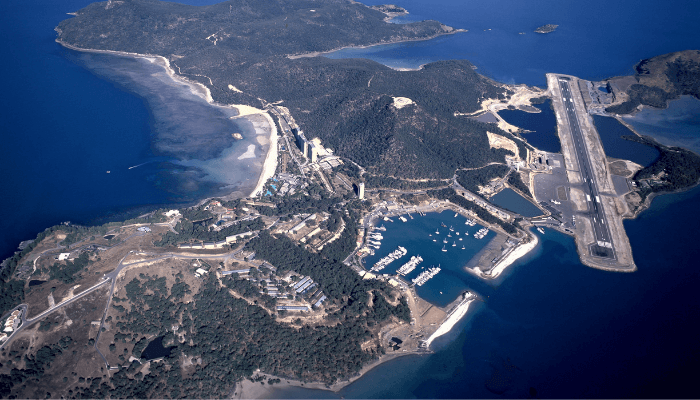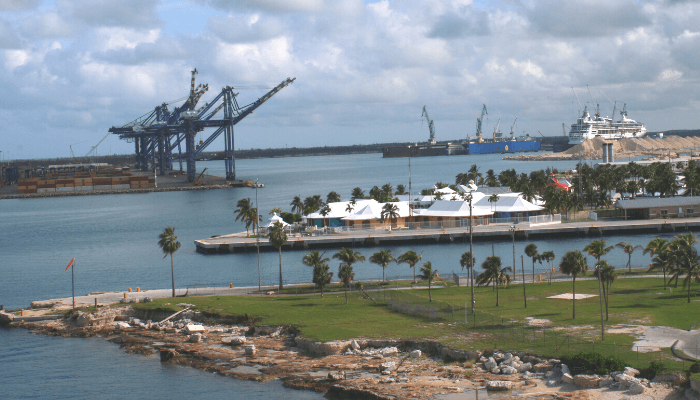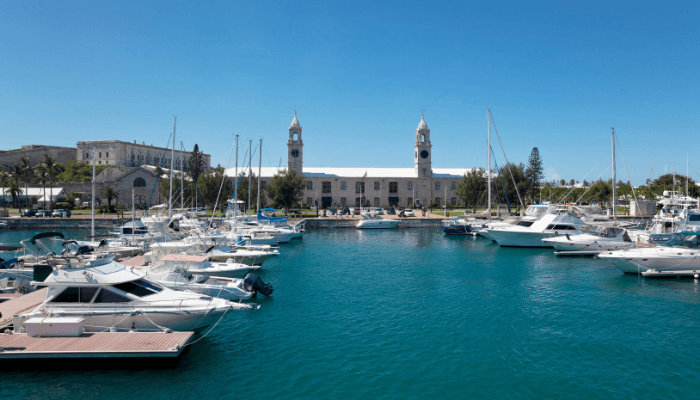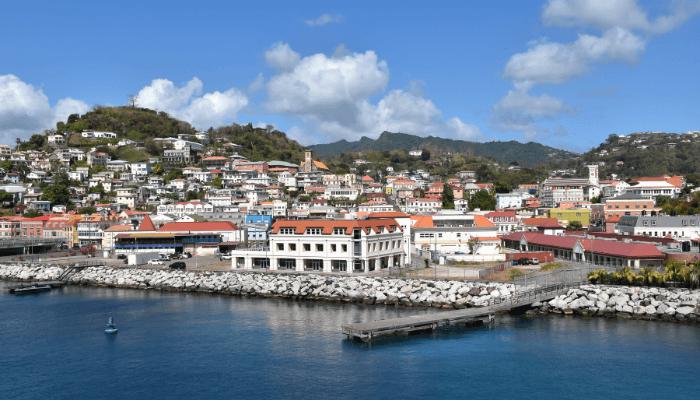

A British overseas territory, Bermuda consists of an archipelago comprising 181 islands. They are positioned in the North Atlantic Ocean close to North Carolina, Havana and Puerto Rico.
The island group is named after a Spanish adventurer called Juan de Bermudez who discovered the main island in 1505. African slaves were shipped to Bermuda from the early 1600s to develop plantations however the attempts did not bear fruit. Instead, a maritime economy emerged with the arrival of the British.
Bermuda became a stopping point for commercial ships, sailors and merchants. Later, the British spent enormous amounts of wealth on building shipping infrastructure and naval defences.
Today, it is a popular cruise destination, visited by a million tourists annually. The parliamentary democracy has a strong banking and services sector which contributes 80% to the GDP. The islands are devoid of heavy industry and sufficient agricultural land, making them heavily dependent on food imports.
They cover almost 54 square kilometres of area and have a 103-kilometre-long coastline dotted with four major ports, the busiest being the Port of Hamilton.
A natural and well-protected harbour, Hamilton is the premier port of Bermuda, lying south of the Spanish point, between the parishes of Pembroke and Paget. An inlet of the Great Sound, the harbour is dotted with numerous small islands which make navigation difficult.
Some prominent islands include the Hinson, Long and Hawkins while the White island is located inside the harbour itself. The easternmost part of the port borders a mangrove bay and forms a triangular shape. It is utilised for mooring pleasure crafts, fishing vessels and small passenger boats.


The harbour is narrow at the edges, hence it cannot accommodate larger Panamax size carriers and new-generation maritime vessels. There have been demands to remove the islands which block the entrance, however, the authorities plan to use its docklands differently. They might relocate the cargo berths even though they bring considerable revenue.
Port history
Hamilton grew into a major business and shipping hub in the early 1800s. Economic growth began with British attempts to convert Hamilton harbour into a major naval base. With the discovery of a safe passage into the harbour by an officer turned captain of the British Royal Navy, Thomas Hurd, Hamilton overtook St George and emerged as the capital of Bermuda. Public infrastructure improved, communications and transportation networks were forged and lands reclaimed.
Economy
The port city of Hamilton has a flourishing economy based on business and tourism. The low corporate tax rates make it an attractive destination for many multinational corporations. Even prominent shipping companies like Frontline Limited are headquartered in Hamilton. It is home to over 150 insurance firms and small manufacturing companies. The town is famous for its sandy beaches, forts and lush green parks, the largest being the Park of Victoria.
Port Layout
The port is operated and managed by the Corporation of Hamilton while cargo operations are performed by private stevedoring companies. Around 800 metres of quayage is available at the port. The main berths are located along Front Street overlooking the waterfront.
Bermuda has only one container handling facility located at the western end of Hamilton city. It consists of four berths for accommodating ships with a maximum overall length of 233 metres and a draught of 8 metres. The freight station has 10 reefer plugs and offers unpacking, stuffing, de-stuffing and storage services. Two 1000 m2 warehouses and an open paved yard are located in the vicinity for storing containers.
General cargo is handled at a 100 metres long wharf with an alongside depth of 7.5 metres. The southern berth has stern ramps for unloading automobiles and motor vehicles arriving from Asian countries like Japan and China.
Approximately 400 vessels carrying 136,500 tonnes of cargo and 15,000 TEUs visit the port every year.
Cruise terminal
Hamilton has a cruise centre comprising two passenger wharves for receiving small and medium-sized ships measuring 750 feet. It is equipped with a waiting room, restrooms, a souvenir shop, a helpdesk and a cafeteria. The marina is bustling with tourists during the season which begins in April and lasts till October. Over 90 trans-Atlantic cruise ships call at the port annually. A ferry terminal lies at the end of Front Street, taking passengers to St-George wharf and other marinas of Bermuda.
Freeport is situated on the northern end of Ireland Island, one of the principal islands of Bermuda, lying on the western part of the archipelago. It is a pleasure port containing the erstwhile naval dockyard and a cruise facility on the southeastern side of the main breakwater. It has two wharves capable of accommodating ships with a maximum LOA of 300 metres and a draught of 10.5 metres.
The island is a part of the Sandy parish and known for its natural beauty. Freeport harbour developed after the end of the American War of Independence in 1775. The British bought lands on the island to construct a lighthouse and a commercial harbour.


Ten years passed in surveying the reefs around the island for constructing functional infrastructure. The harbour was built gradually and served as an important winter headquarters during the war of 1812. It was transformed into the main naval base of the British navy between Nova Scotia and the West Indies.
A new southern yard was built in the 18th century and the former was called the northern shipyard. Both are protected by breakwaters and accommodate pleasure crafts and yachts. Warships were moored at the Murray and Grassy Bay anchorages, however, additional space inside the harbour area enabled the construction of floating dry docks in the 1850s.


Once an important trading outpost for the British, the Royal Naval Dockyard is now the busiest cruise port in Bermuda. It has two cruise piers, the King’s wharf and the Heritage wharf for accommodating the largest cruise ships that cannot enter St George town of Hamilton harbour. The dockyard is situated on the northern end of Ireland Island and handles 500,000 tourists every year.
Port history
After suffering a crushing defeat in the American war of independence, the British also lost their coastal territories situated along the Atlantic coast of America. Hence, they constructed the royal Naval Dockyard for carrying out naval operations in the region.
The king’s wharf was built in 1809 by the hard labour of the natives. The harbour operated for a century and was the most prized possession. A six-acre fortification surrounding the port was put in place for safeguarding against enemy invasions.
Also, an artificial pond was created close to the fort entrance for transferring ammunition to the ships docked at the harbour. However, after the British and Americans became allies, the dockyard ceased to be a defence post for the former. With this declaration, most facilities at the harbour closed in the 1950s.
The authorities began to develop tourism infrastructure on the island and the erstwhile naval dockyard became a commercial complex housing many tourist attractions.
King’s Wharf received its first cruise ship in 1990. The heritage wharf was inaugurated in 2009 for handling the influx of cruise vessels.
Port Layout
After getting off the cruise ship, tourists can walk from the pier to the exit gate. Since the harbour covers only 24 acres, everything is within walking distance.
The harbour contains world-class, modern facilities for international travellers. It is a world within itself, providing an array of fun-filled activities. Inside the complex are many themed attractions, shopping centres, cafes and pubs, a national museum and much more. One can also book all sorts of excursions at the port complex ranging from sailing to kayaking, fishing, paddle boarding etc.
Most importantly, the harbour has a service centre which offers free maps, pamphlets and other important information to tourists. It is close to the main bus stand and the taxi booths.
The island has a sub-tropical climate, perfect for soaking up some sunlight and relaxing at the beaches. Most cruises arrive in April and leave as late as November.
The dockyard is well-linked with Hamilton and St George town through ferries. The ferry terminal is just 600 yards from the King’s Wharf.
Famous tourist spots
Many pink sand beaches are just a five-minute walk from the King’s Wharf. One such is the Snorkel park which has facilities for snorkelling, scuba diving and sailing. It has a bar, people can rent beachside huts and enjoy night camping as well. The place is also known for jet skiing and annual regattas.
Showcasing the maritime history of Bermuda, the National Museum is situated within the precincts of the fortification. A dolphin interaction centre lies inside the museum, hosting water shows twice a day.
The Art gallery exhibits sculptures and paintings of local artists while the glassworks showcase exquisite items made using a special glass-blowing method.
The dockyard also has many historical buildings such as the Victualling yard, once used by the British navy for keeping their supplies. Beautiful wooden handicrafts and hand-made pottery are sold in the pottery lane. The world’s smallest drawbridge is only two kilometres from the harbour.
Lastly, one of the world’s oldest cast-iron lighthouses, the Gibbs Hill lighthouse was constructed in 1846. The structure is open to the public and contains 185 stairs, offering a panoramic view of the magnificent Great Sound.
A medium-sized natural harbour, it lies on the northern end of the archipelago on the island of St George. Several small islands enclose the harbour from all sides. One such is Ordnance island which served as the ammunition depot for the British.


Ferry Reach is a narrow water channel which connects the port with the beautiful Castle Harbour and opens up to the Atlantic. Sailors are advised to navigate carefully since it is lined with coral reefs.
Port History
George town is the site of the first and the oldest English settlement in Bermuda. It was populated in the early 17th century by British adventurers. An English ship, Sea Venture visited the island in 1609 and stayed for a year. Some of its crew members stayed back while others returned. In 1610, Englishmen frequented the island and some chose to settle on the nearby St. David’s island before carving out the town of St George in the 18h century.
Many forts, churches, public parks and buildings were constructed in what is now called the old capital. Interestingly, this cultural heritage has been added to the UNESCO World Heritage list and St George was accorded the status of an important historical town.
Port Characteristics
The port consists of a cruise berth, a repair facility and an 80-metre-long general cargo wharf. The harbour also has a jetty for accommodating oil tankers, operated by the company Esso Bermuda. Approximately 250 vessels and 22,000 tonnes of cargo pass through the port annually. Ships with a maximum LOA of 212 metres and a draught of 8 metres can easily dock at the port of St George.
Though Hamilton port handles more than 50 per cent of Bermuda’s international trade, St George is the only entry point for yachts which must fulfil all customs formalities at the Island of Ordnance before venturing into the marina, or else they can be fined. It also receives breakbulk like cement, raw material, consumer goods and manufactured items.
Disclaimer: The authors’ views expressed in this article do not necessarily reflect the views of The Marine Learners. Data and charts, if used, in the article have been sourced from available information and have not been authenticated by any statutory authority. The author and The Marine Learners do not claim it to be accurate nor accept any responsibility for the same. The views constitute only the opinions and do not constitute any guidelines or recommendation on any course of action to be followed by the reader.
The article or images cannot be reproduced, copied, shared or used in any form without the permission of the author and The Marine Learners.










We believe that knowledge is power, and we’re committed to empowering our readers with the information and resources they need to succeed in the merchant navy industry.
Whether you’re looking for advice on career planning, news and analysis, or just want to connect with other aspiring merchant navy applicants, The Marine Learners is the place to be.